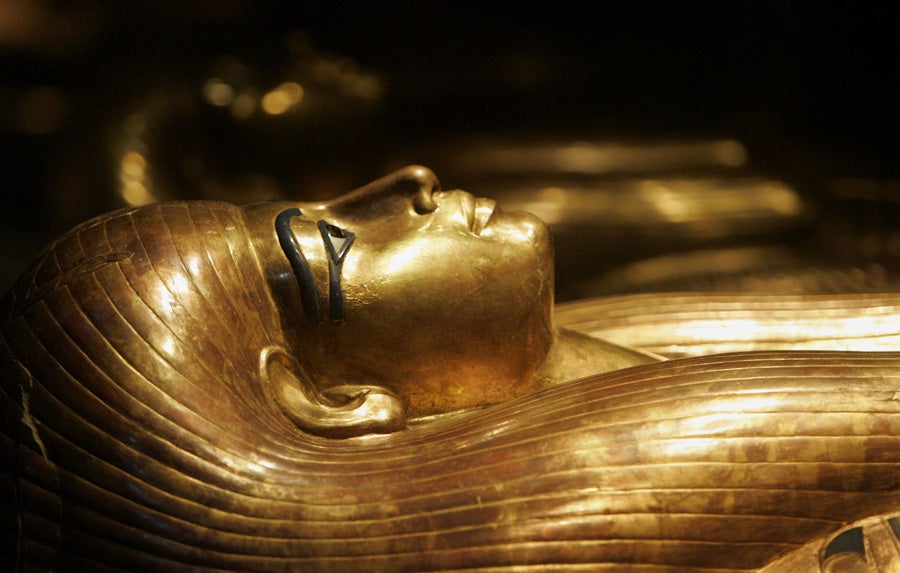Rare find
ListenAn ancient stone owned by Tutankhamun has been identified as a piece of comet nucleus, the first ever discovered on Earth. The one ounce piece of dark stone fell to earth 28 million years ago in what is modern-day Egypt and was incorporated into a scarab broach owned by King Tut 3,200 years ago. Micro particles of comet dust are found in the atmosphere or in carbon-rich arctic ice layers but never before anything this size. Meteoritic material used for tools and jewelry for thousands of years – lots of material on earth, iron stuff easily found. Venus low in the west at sunset, Jupiter rises at midnight, Mars around 3 a.m.
October 14, 2013
-

A gilded and elaborately decorated coffin for Tjuya, believed to be the great-grandmother of King Tut, is displayed Wednesday, May 24, 2006, in Chicago at a preview of The Field Museum’s new exhibit “Tutankhamun and the Golden Age of the Pharaohs.” The exhibition features more than 130 treasures from the resting place of the pharaoh known as the “the boy king,” and other royal tombs, all between 3,000 and 3,500 years old. (AP Photo/M. Spencer Green)
[Dave Heller] It’s an out-of-this-world find that brings to mind the Staff of Ra from Raiders of the Lost Arc. Let’s travel back to ancient Egypt with Derrick Pitts, chief astronomer at the Franklin Institute. I’m ready to go on an adventure.
[Derrick Pitts] And what an adventure it’s gonna be! It’s at least 28 million years long, and takes us back all the way to the beginning of the universe. No, the beginning of the solar system. But way back at least, anyway.
And then fast-forward to a mere 3,200 years ago.
And so here we are now, out in Egypt along with King Tut and the rest of his crew. And what do we stumble across? Well, we find this interesting region that has a small bit of fused silica — turns out to look like yellow glass — and embedded within this is this one-ounce chunk of very unusual material that none of his people have ever seen before. Little do they know that it’s actually extraterrestrial and will eventually be identified as the first of its type of material to ever be found on the surface of the Earth.
And so just what is this stuff?
It is a piece of the nucleus of a comet! Strangest of strange things to ever be found. Yes, we know that there’s comet dust that floats down in the Earth’s atmosphere, and comet dust that we also find in the ice sheets in the arctic regions. But to actually find something that is a one-ounce solid lump — that’s very unusual indeed.
What is the composition of this lump?
Whereas we might interpret it to be very much like a form of a meteorite — either silicon-based or iron-based — what we do find is that the carbon content is 20 times higher than what we find in a normal meteorite. So this seems to be incredibly carbon-rich, and that along with other chemical signatures identifies it more as being a comet nucleus than being like a meteorite.
So this comet nucleus is the rarest of gems on Earth.
And even odder it is that this turned into a piece of jewelry by King Tut’s jewelry workers.
I’m in need of a refresher — distinguish a comet and its composition from a meteorite and what it’s made of.
Well, a comet itself is a ball of frozen gas and dust. And in this case we happen to be able to find a very large hunk of the dust, if you will, one nugget about an ounce in size from a comet. A meteor, on the other hand, is a small hunk of space rock. And they typically tend to be iron or, more so than anything else, they tend to be very much more like rocky materials that we’d find here on Earth. But they typically are incredibly small. In this case we found something that’s fairly on the large side and has a much higher carbon content that indicates a difference in origin. So that’s what points this one towards being identifiable as of comet origin rather than meteoritic origin.
Do meteoritic-originated materials find uses in cultures that go back millennia?
Civilized peoples have been able to configure these meteoritic materials into various kinds of tools. Remember, when you find an iron meteorite, very often you’re finding a piece of iron that hasn’t had to have been made, smelted or processed in some sort of industrial process. So it’s natural iron that can be found and used for all of those things that you could use iron for. So this becomes very important and very useful in a developing civilization until we finally figure out how to make it from ore and create manufactured iron. So these would have been very, very valuable tools to use for all sorts of reasons. Indeed at the same time, sometimes they’ve even been used as jewelry, depending upon the shape and the configuration as was done with the piece of comet nucleus material. It was turned into a scarab broach that was used by King Tut.
Derrick, dodging meteorites and comet nuclei of course, let’s head out of doors this evening.
If we step outside looking toward the west in the evening, we can see Venus low in the west at sunset. But it’s working its way up in the next week or so and you’ll be able to see it higher next week. But Jupiter rises at midnight, a little bit before midnight now, and it’s very high in the southeastern sky by two hours before sunrise, and it’s very easy to see. Mars is also rising in the east at about 3 a.m., so it’s also visible in the pre-dawn sky.
WHYY is your source for fact-based, in-depth journalism and information. As a nonprofit organization, we rely on financial support from readers like you. Please give today.




